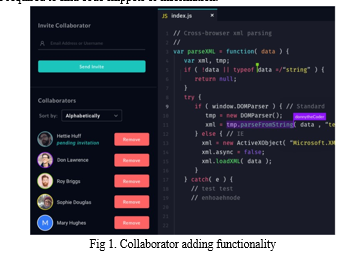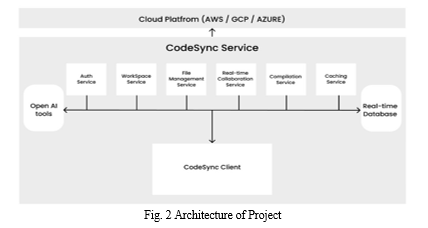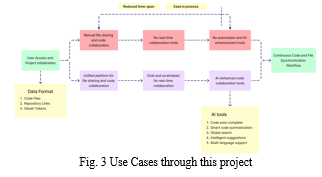Ijraset Journal For Research in Applied Science and Engineering Technology
- Home / Ijraset
- On This Page
- Abstract
- Introduction
- Conclusion
- References
- Copyright
A Collaborative Code Platform with Advanced AI Features and Real-Time Collaboration Tools
Authors: Aarti Gaikwad, Anudip Gupta, Pranav Yeole, Saurabh Barde, Nishant Bhosale, Prathamesh Baste
DOI Link: https://doi.org/10.22214/ijraset.2024.61438
Certificate: View Certificate
Abstract
Good collaboration and code management are crucial in today\'s software development environment. Our research has launched a new collaborative process that combines AI resources, including AI and global research, to improve products and enhance and facilitate collaboration. The platform features real-time collaboration tools such as dynamic text with multi-language support, dialog functionality, and notepad functionality. With OAuth authentication, users can seamlessly perform CRUD operations on files and directories, share code repositories, and participate in live coding sessions. The platform supports compilation and execution of a code file and follows good design principles such as caching, microservices architecture, and containerization to ensure scalability and performance. The platform focuses on user experience by providing simple user interface design and easy interface navigation. Users can create workspaces, share them collaboratively, and seamlessly import repositories from Git. The platform\'s intelligent data manager helps manage files and directories, while the collaborative platform allows developers to collaborate on code libraries efficiently. The platform is modern web-based, using React on the frontend and Node.js on the backend; Supported with syntax highlighting and smart initialization along with Socket.io for runtime with SQL and NoSQL databases. Provides comprehensive language support. All progress is saved, providing users with peace of mind. While the basic design is for desktops, future iterations are expected to support mobile devices.
Introduction
I. INTRODUCTION
Consider a situation where a software development team is grappling with the complexity of a collaborative coding project and encountering challenges in facilitating effective collaboration and data management. An AI-powered policy collaboration and data management platform emerges as a solution that promises to transform traditional practices by integrating AI with this capability. The platform redefines the user experience by providing a unified environment for managing disparate data while supporting real-time, intelligent code creation and sharing. The platform focuses on improving efficiency, encouraging collaboration, and leveraging technology resources and promises to redefine the collaboration software space. Similarly, the cryptocurrency market has experienced unprecedented growth and volatility in recent years. It has attracted the attention of countless investors and traders over the years. However, the uncertainty of the cryptocurrency price poses a significant problem for those looking for this beautiful place. Traditional financial models cannot capture the nuances of the cryptocurrency market, so new price prediction methods are needed. Our research explores the field of machine learning (ML) with the aim of improving the accuracy and reliability of cryptocurrency price predictions. We aim to provide investors and traders with better insights into the cryptocurrency market by exploring various machine learning algorithms, data sources and parameters. In the next section, we will begin to share our research methods and results, detailing the complexity of machine learning-based cryptocurrency price prediction models. We present data selection, the sophistication of machine learning algorithms, and the integration of external data such as opinion polls from social media platforms. Our efforts make a significant contribution to changing the debate around the cryptocurrency market by providing a unique perspective on machine learning's ability to identify market dynamics. As we navigate this uncharted territory, our research is dedicated to providing investors, traders, and financial professionals with the tools and information they need to always be successful in the cryptocurrency business.
II. LITERATURE REVIEW
- Automatic Code Summarization: A Systematic Literature - During software maintenance and development, the comprehension of program code is key to success. High-quality comments can help us better understand programs, but they're often missing or outmoded in today's programs. Automatic code summarization is proposed to solve these problems. During the last decade, huge progress has been made in this field, but there is a lack of an up-to-date survey.
- Same File, Different Changes: The Potential of Meta-Maintenance on GitHub - Online collaboration platforms such as GitHub have provided software developers with the ability to easily reuse and share code between repositories. With clone-and-own and forking becoming prevalent, maintaining these shared files is important, especially for keeping the most up-to-date version of reused code. Different to related work, we propose the concept of meta-maintenance-i.e., tracking how the same files evolve in different repositories with the aim to provide useful maintenance opportunities to those files.
- Code Search: A Survey of Techniques for Finding Code - The immense amounts of source code provide ample challenges and opportunities during software development. To handle the size of code bases, developers commonly search for code, e.g., when trying to find where a particular feature is implemented or when looking for code examples to reuse. To support developers in finding relevant code, various code search engines have been proposed.
- The Ubiquitous Digital File: File management research - Computer users spend time every day interacting with digital files and folders, including downloading, moving, naming, navigating to, searching for, sharing, and deleting them. Relevant conceptual frameworks and approaches to designing and testing systems are described, and open research challenges and the significance for other research areas are discussed. File management is a ubiquitous, challenging, and relatively unsupported activity that invites and has received attention from several disciplines and has broad importance for topics across information science.
III. METHODOLOGY
A. Core Features and System Architecture
- Integration of AI Features: Intelligent code summarization powered by Artificial Intelligence uses machine learning models to analyze code and create concise summaries to improve developer understanding and collaboration. The system uses a combination of NLP techniques and syntax analysis to deliver fact-aware content. An AI-generated global search feature that uses semantic search that understands the context of the code and the developer's intent to ensure effective code navigation and access reduces the time required to find code snippets or information.

2. Real-time Collaboration Tools: Created flexible scripts that support multiple user update programs using Operations Update (OT) to ensure consistency across all user programs. These features are complemented by a chat function that allows seamless team communication and a sticky note for collaborative writing. The platform allows fast updating and synchronization of all client connections using the WebSocket protocol for instant data transfer.
3. System Design Principles: The platform was designed using a microservices architecture to provide scalability and flexibility; each service runs in its own container for independent expansion and maintenance. Use caching and load balancing policies to improve performance and resource utilization. Get a robust CI/CD pipeline to enable microservices to be tested, integrated, and deployed for speed and reliability on a modified platform.

B. Development and Implementation Strategy
- User Authentication and Authorization
Integrate OAuth 2.0 to provide authentication, allowing users to perform CRUD operations on files and lists with appropriate permissions. The system manages secure communications and provides access control functions for multiple operating platforms. The authentication process is powered by JSON Web Tokens (JWT) to secure real-time users and support stateless authentication across microservices.
2. Code Compilation and Execution Environment
Created a separate workspace for compiling and executing program code that supports multiple programming languages. This site is sandboxed to prevent unauthorized access and ensure the security of user submissions. Using Docker containers to isolate individual code execution requests to maximize potential and ensure user code runs safely and efficiently without impacting profits.
???????3. UI/UX Design and Mobile Support:
Designed an intuitive and responsive user interface using React, focusing on easy navigation, accessibility, and seamless user experience. The design is optimized for desktop and anticipated mobile support to ensure the same usability across devices. Front-end and back-end Node.js services interact well, providing an abstract solution for instant collaboration even in high-pressure environments.
C. Security Measures and Data Management
- Secure File and Directory Management
The design was to ensure the security and efficiency of code files and directories, the smart file manager allows users to easily organize, share and coordinate update activities while maintaining strict control and auditing methods. Security measures include transmission and interception, regular scanning of data storage, and the use of strict rules to prevent unauthorized or modified data.
???????2. Ensuring Code Collaboration Security
Security protocols developed for live coding sessions include end-to-end encryption, real-time threat detection, and automatic code verification, ensuring shared coding is protected against external threats and internal risks. The platform uses logging and monitoring to ensure collaborative coding is protected from external threats and internal risks. It tracks all user activity during the shared session, allowing you to quickly respond to any crime or security breach.
???????3. Scalability and Maintenance
Used the powerful tools that Kubernetes offers to scale microservices on demand. This ensures that the platform can handle multiple tasks and maintain high performance and efficiency. Made a combination of SQL and NoSQL databases to improve data storage and retrieval performance and quickly and reliably support the platform's access-requiring data management systems.
D. Future Directions and Enhancements
Future versions of the platform will focus on expanding artificial intelligence, improving content intelligence with deep learning models, and expanding global research to include different languages ??and methods. There are plans to expand mobile support to help developers use their mobile devices and integrate additional functionality out of the box to increase the interoperability and versatility of the platform.
 ???????
???????
Conclusion
Our research introduces a state-of-the-art code collaboration platform that integrates advanced AI such as intelligent code summarization and global search, aiming to optimize developer productivity and improve coding practice sharing. The platform integrates real-time collaboration tools, including negative text, interactivity features, and multi-text to provide a seamless and accessible environment that helps developers work together in real-time and improve the coding experience. The use of OAuth authentication combined with CRUD functionality, secure data sharing and live coding sessions provides high security while supporting flexibility and user-friendly interface management code. The system\'s backend architecture leverages a microservices approach and containerization and is designed for scalability and high availability, ensuring the platform can handle increasing loads without compromising performance. This unique platform combines existing collaboration, artificial intelligence, and a focus on security and scalability to prove the massive rise in software development tools. The integration of modern communication technologies and the application of best design practices introduce the platform as a new way to enhance collaborative production. Software development projects are becoming more complex and require tools that not only increase efficiency but also facilitate collaboration and innovation among developers. Our platform meets these needs by providing standard-setting solutions by combining the power of artificial intelligence, real-time collaboration, and security. Full integration of smart code and the smart code global search engine provides developers with smart tools to simplify coding techniques and improve code quality. Instant collaboration can transform a standard coding environment into a powerful, interactive workspace that encourages teamwork and gets projects done. Security is a priority on our platform, with advanced authentication, authorization, and data protection measures to ensure all interactions occur in a secure and controlled environment. By considering the platform\'s scalability, microservice architecture and containerization, it has been ensured that it can be adapted to the needs of today\'s software developers. In summary, our research contributes to the development of software by providing a platform that not only increases the productivity and performance of the developer, but is also important in terms of security, coordination, and empowerment. Future developments will focus on expanding the platform\'s capabilities, including more AI-powered tools, and continuing to improve security. The impact of this research is far-reaching and it is hoped that it will shape the future of how developers collaborate, share and innovate in software development.
References
[1] Rohit Katiyar, Dr. R. K. Ghosh. A peer-to-peer file storage and sharing system https://www.researchgate.net/publication/228856408_A_peer-to-peer_file_storage_and_sharing_system [2] Moore, Madison (14 June 2016). \"Nokia IoT portfolio, SmartBear introduces Collaborator 10.0, and new Google Springboard and Google Sites—SD Times news digest: June 14, 2016\". https://sdtimes.com/applications/nokia-iot-portfolio-smartbear-introduces-collaborator-10-0-new-google-springboard-google-sites-sd-times-news-digest-june-14-2016/ [3] Bridgwater, Adrian. \"Peer Review Across Docs and Code\" https://www.drdobbs.com/testing/peer-review-across-docs-and-code/240150143 [4] Berkholz; Gilma, Donnie; Marie. \"SmartBear releases new version of Collaborator code-review tool\" https://www.drdobbs.com/testing/peer-review-across-docs-and-code/240150143 [5] Integrate Virtual Magic to your hospitality with AR Food Menu, 2019. [Online]. https://quy-technology.medium.com/augment-virtual-magic-to-your-hospitality-with-arfood-menu-80eb088888d5 [6] Aditya Kurniawan, Christine Soesanto, Joe Erik Carla Wijaya. CodeR: Real-time Code Editor Application for Collaborative Programming https://www.sciencedirect.com/science/article/pii/S1877050915020608
Copyright
Copyright © 2024 Aarti Gaikwad, Anudip Gupta, Pranav Yeole, Saurabh Barde, Nishant Bhosale, Prathamesh Baste. This is an open access article distributed under the Creative Commons Attribution License, which permits unrestricted use, distribution, and reproduction in any medium, provided the original work is properly cited.

Download Paper
Paper Id : IJRASET61438
Publish Date : 2024-05-01
ISSN : 2321-9653
Publisher Name : IJRASET
DOI Link : Click Here
 Submit Paper Online
Submit Paper Online

